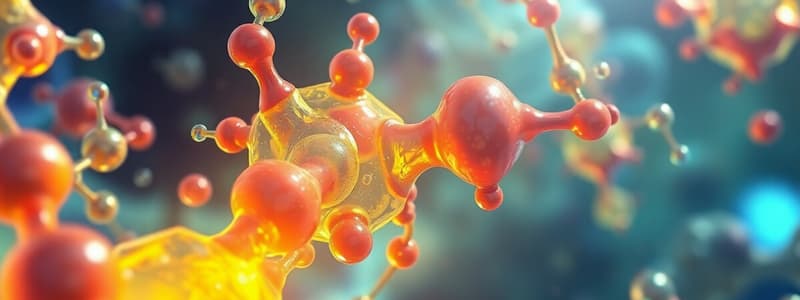Podcast
Questions and Answers
What type of reaction do hydrolases primarily catalyze?
What type of reaction do hydrolases primarily catalyze?
- Splitting of covalent bonds with water addition (correct)
- Isomerization of molecules
- Formation of covalent bonds
- Addition of double bonds
Which of the following is NOT a category of enzymes mentioned?
Which of the following is NOT a category of enzymes mentioned?
- Lyases
- Isomerases
- Hydrolases
- Oxidases (correct)
What role do ligases/synthetases play in biochemical reactions?
What role do ligases/synthetases play in biochemical reactions?
- Aid in the addition of hydrogen ions
- Form bonds with ATP cleavage (correct)
- Promote isomerization
- Catalyze hydrolysis reactions
What does the suffix '-ase' in enzyme nomenclature signify?
What does the suffix '-ase' in enzyme nomenclature signify?
Which subclass of isomerases is specifically mentioned in the content?
Which subclass of isomerases is specifically mentioned in the content?
What is the function of proenzymes, also known as zymogens?
What is the function of proenzymes, also known as zymogens?
In the enzyme nomenclature system, what does the first digit in the enzyme code (EC) signify?
In the enzyme nomenclature system, what does the first digit in the enzyme code (EC) signify?
Which of the following statements is true regarding lyases?
Which of the following statements is true regarding lyases?
What role do enzymes play in chemical reactions?
What role do enzymes play in chemical reactions?
What is one of the functions of creatine kinase?
What is one of the functions of creatine kinase?
Which enzyme is known for breaking down mucus in lungs of cystic fibrosis patients?
Which enzyme is known for breaking down mucus in lungs of cystic fibrosis patients?
Which enzyme is NOT typically used in food processing as mentioned?
Which enzyme is NOT typically used in food processing as mentioned?
What characteristic distinguishes enzymes from other proteins?
What characteristic distinguishes enzymes from other proteins?
Which enzyme is commonly used as a digestive aid in pre-cooked foods?
Which enzyme is commonly used as a digestive aid in pre-cooked foods?
What type of substance are enzymes classified as?
What type of substance are enzymes classified as?
What is the function of the active site of an enzyme?
What is the function of the active site of an enzyme?
Which enzyme is used to remove protein stains in detergents?
Which enzyme is used to remove protein stains in detergents?
Which type of specificity refers to an enzyme acting only on one optical isomer?
Which type of specificity refers to an enzyme acting only on one optical isomer?
What is a holoenzyme?
What is a holoenzyme?
How do the electrical charges of enzymes vary with pH?
How do the electrical charges of enzymes vary with pH?
What are coenzymes primarily characterized by?
What are coenzymes primarily characterized by?
Which of the following is NOT a category of enzymes in the International Classification of Enzymes?
Which of the following is NOT a category of enzymes in the International Classification of Enzymes?
Which of the following describes absolute specificity in enzymes?
Which of the following describes absolute specificity in enzymes?
What role does a coenzyme play in an enzymatic reaction?
What role does a coenzyme play in an enzymatic reaction?
At what temperature does maximum enzyme activity typically occur?
At what temperature does maximum enzyme activity typically occur?
What pH range typically results in optimal enzyme activity?
What pH range typically results in optimal enzyme activity?
What does Koshland's Induced Fit Theory suggest about the enzyme-substrate interaction?
What does Koshland's Induced Fit Theory suggest about the enzyme-substrate interaction?
Which enzyme is represented by the EC classification 2.7.1.1?
Which enzyme is represented by the EC classification 2.7.1.1?
Which metal is NOT typically considered a cofactor for enzyme activity?
Which metal is NOT typically considered a cofactor for enzyme activity?
What effect does increasing substrate concentration have on enzyme activity?
What effect does increasing substrate concentration have on enzyme activity?
How does temperature affect enzyme-catalyzed reactions?
How does temperature affect enzyme-catalyzed reactions?
What is the main idea behind Fischer’s Lock and Key Theory?
What is the main idea behind Fischer’s Lock and Key Theory?
What is the role of activators in enzyme functionality?
What is the role of activators in enzyme functionality?
What role do functional groups at the catalytic site of enzymes play?
What role do functional groups at the catalytic site of enzymes play?
What happens to enzyme activity when reaction products accumulate?
What happens to enzyme activity when reaction products accumulate?
What effect do ultraviolet rays have on enzyme activity?
What effect do ultraviolet rays have on enzyme activity?
Which of the following pH values is optimal for trypsin activity?
Which of the following pH values is optimal for trypsin activity?
Which of the following statements about enzyme concentration is true?
Which of the following statements about enzyme concentration is true?
What occurs when enzyme temperature exceeds 70°C?
What occurs when enzyme temperature exceeds 70°C?
What does the Activation by Strain or Bond Distortion Theory propose?
What does the Activation by Strain or Bond Distortion Theory propose?
Flashcards are hidden until you start studying
Study Notes
Enzymes
- Enzymes are biochemical catalysts synthesized by living cells.
- They speed up chemical reactions and facilitate continuous replacement and renewal processes in living organisms.
- Enzymes regulate the rates of physiological processes, playing critical roles in health and disease.
- Enzymes are colloidal substances and proteins in nature.
- They can be found in crystalline form.
Properties of Enzymes
- Catalytic Power: Enzymes possess immense catalytic power, meaning they can be reused for multiple catalytic reactions.
- Specificity: Enzymes are highly specific in their action.
- Substrate Specificity: Each enzyme acts on a specific substance called a substrate.
- Reaction Specificity: Enzymes catalyze only a specific type of reaction.
- Electrical Charges: Enzymes have electrical charges that depend on the pH of the environment.
- Positive (+) charge for enzymes with a pH greater than 7.
- Negative (-) charge for enzymes with a pH less than 7.
Components of an Enzyme
- Active Site: The functional part of an enzyme where the catalytic activity occurs.
- Binding Site: A portion within the active site that attracts and binds the substrate.
- Catalytic Site: The area within the active site that directly facilitates the chemical reaction.
Coenzymes
- Coenzymes are heat-stable, low-molecular-weight organic compounds that are required for the activity of some enzymes.
- They are linked to enzymes by non-covalent bonds.
- Coenzymes act as acceptors for fragments during substrate degradation.
- The protein portion of an enzyme is called an apoenzyme.
- When an apoenzyme combines with its coenzyme, it forms a complete enzyme called a holoenzyme.
International Classification of Enzymes
- Enzymes are classified into six classes, each with subclasses and sub-subclasses, based on the type of reaction they catalyze.
- Each enzyme has a unique enzyme code (EC) consisting of four digits:
- Class (First Digit): Indicates the general type of reaction.
- Subclass (Second Digit): More specific type of reaction.
- Sub-subclass (Third Digit): Further refinement of the reaction type.
- Specific Enzyme (Fourth Digit): Unique identifier for a specific enzyme.
- Example: EC 2.7.1.1 refers to hexokinase, an enzyme that catalyzes the transfer of a phosphate group from ATP to glucose.
Theories of Enzyme Activity
- Lock-and-Key Theory (Fischer): The active site of the enzyme perfectly complements the shape of the substrate.
- Induced Fit Theory (Koshland): The enzyme undergoes a conformational change to accommodate the substrate.
- Adsorption Theory: The enzyme's surface area concentrates reactants, increasing the frequency of collisions and accelerating reactions.
- Activation by Strain or Bond Distortion Theory: The enzyme distorts the bonds of the substrate, weakening them and facilitating bond breaking.
- Functional Groups at the Catalytic Site Theory: Amino acid residues or metal ions at the active site act as acids, bases, nucleophiles, or electrophiles to facilitate the reaction.
Factors Affecting Enzyme Activity
- Enzyme Concentration: Increasing enzyme concentration increases reaction velocity.
- Substrate Concentration: Reaction velocity increases with rising substrate concentration until the enzyme is saturated.
- Temperature: Increased temperature generally increases reaction velocity, but only within a narrow range. The optimal temperature for most enzymes is around 37-40°C.
- pH: Most enzymes have an optimal pH range, usually between 5 and 9.
- Cofactors: Cofactors, often metal ions, enhance enzyme activity.
- Activators: Some enzymes require activators to become active.
- Product Accumulation: The accumulation of products can inhibit enzyme activity due to the reversibility of enzyme action.
- Inhibitors: Inhibitors block enzyme activity.
- Reversible Inhibition: The inhibitor binds temporarily, and enzyme activity can be restored.
- Irreversible Inhibition: The inhibitor binds permanently, permanently inactivating the enzyme.
- Time: Optimum temperature and pH are effective only within specific time frames.
- Light and Other Physical Agents: Light and physical agents can influence enzyme activity.
- Blue and red light can increase salivary amylase activity.
- Ultraviolet rays and radium can inhibit enzyme activity.
- Violent shaking can destroy enzyme activity.
Enzyme Nomenclature
- Enzymes are named using the suffix "-ase," preceded by a term indicating:
- The substrate or substrate class
- The specific reaction catalyzed
- A combination of both
- Enzymes that catalyze hydrolysis reactions may use the suffix "-lytic."
- Inactive enzyme precursors (proenzymes or zymogens) use the suffix "-ogen."
- The International Union of Biochemistry (IUB) uses a complex but unambiguous system for enzyme nomenclature based on reaction mechanisms.
Studying That Suits You
Use AI to generate personalized quizzes and flashcards to suit your learning preferences.




